Deep Rooted Wisdom: Old Gardens, Old Gardeners, Fresh Knowledge
“Behind the fine house, the old outbuildings protected chickens, donkeys, dogs, cats, and the paraphernalia associated with working an old farm. There were pecan trees, flower gardens laid out in loose, joyful style, and well-worn paths to clothes lines and outbuildings and pens. And there were rows upon rows of exuberant colorful crinums growing in their own field . . . .”—By William A. Balk, Jr.
Epicurus’ Porch
By William A. Balk, Jr.
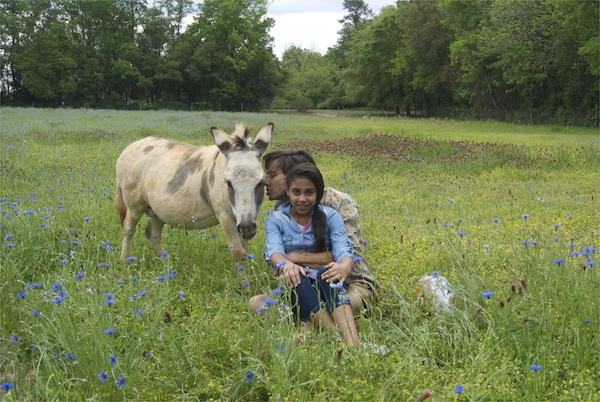
 BEAUFORT South Carolina—(Weekly Hubris)—5/12/2014—At one time, a gardener would rely on other gardeners’ experience and knowledge to increase his own expertise and to improve his own garden or to correct a particular problem. Farmers, too, found that other farmers often had resources and solutions to the challenges each had faced. These days, most of our farming and gardening information seems to come from the same giant multi-national corporations that sell us the seeds and chemicals that unsurprisingly are recommended in their widely-distributed articles and materials.
BEAUFORT South Carolina—(Weekly Hubris)—5/12/2014—At one time, a gardener would rely on other gardeners’ experience and knowledge to increase his own expertise and to improve his own garden or to correct a particular problem. Farmers, too, found that other farmers often had resources and solutions to the challenges each had faced. These days, most of our farming and gardening information seems to come from the same giant multi-national corporations that sell us the seeds and chemicals that unsurprisingly are recommended in their widely-distributed articles and materials.
In 19th-century agrarian America, planters, farmers, and gardeners realized that sharing their knowledge and experience often improved all their production; they began forming societies which offered opportunities for the regular sharing of difficulties and solutions to problems that they often saw in their own production.
One such organization—which most American children learn about in school—is the American Grange, which was formed after the Civil War to promote good farm husbandry and good citizenship. Even before the Civil War, however, farmers and planters had begun to meet regularly to improve practices and production. These Agricultural Clubs arose in many farming areas; the oldest such club still in existence, organized in 1857, meets in Beech Island, South Carolina. These clubs’ role in history rarely is taught in school.
By the time my father had become a member of the Ellenton Agricultural Club, organized in 1894, that club had become less of a farm husbandry meeting and more of a fraternal organization. Its bylaws specified to the most minute detail the meal that was to be served at the meetings, and the rotating hosts risked condemnation if not banishment for any breach of the menu requirements—barbecued pork, cole slaw, potato salad, yeast rolls, iced tea—and the day-long pit-cooking it required. The meeting itself, closed to outsiders, was now more concerned with local civic issues than with agricultural ones. Nonetheless, the century of meetings as recorded in the minutes shows intense concern with soil depletion, crops destroyed by pests, new methods for controlling erosion, and scientific studies from the Department of Agriculture.
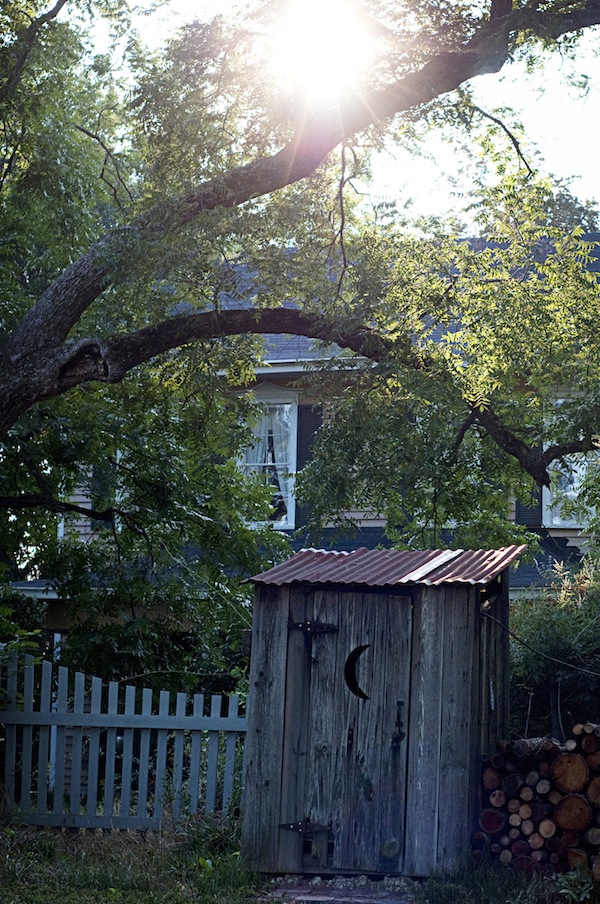
Most gardeners, I think, are alert to opportunities to learn from other gardeners and to offer suggestions from their own experiences in the garden. We often share cuttings and seeds and divided portions from our plantings. Experience is indeed a superb teacher.
There are other sources for valuable information as well. There are brilliant scientists doing superb research in agriculture and horticulture, in soil sciences and ecology. There are gardeners who have spent their entire lives exploring techniques and materials which most of us have no knowledge of.
During one of my own periodic compulsive explorations, searching out every bit of information I could track down about some new area of horticulture I didn’t know enough about, I trekked the southeastern US coastal states in search of the then-elusive crinum.
I had grown up in rural surroundings, and I knew by sight and by appreciation that old shacks and grand mansions alike often had huge clumps of giant flowering bulbs. They reminded me of amaryllis, and I heard people call them milk-and-wine lilies if the flowers were striped dark pink and white. Some, though, were a solid pink or a pure white; those seemed to have no name. In the formal gardens of The Castle, the huge brick antebellum mansion on The Old Point in Beaufort, South Carolina, I stood in awe beside giant strap-leaved examples of this great plant, topped this time by five-foot-tall scapes of a dozen spidery white flowers. I determined then that I’d figure out what this much varied bulb really was—and to try growing it.
Thus began in the early 1990s my travels in search of knowledgeable growers and plantsmen who might help me learn more about the genus Crinum, and who might help me acquire some examples to try in my own garden. At the time, the crinum had suffered from being quite out of fashion; few nurseries offered any varieties at all, and those who did usually had a single type at extremely expensive prices. Undaunted, I kept traveling and searching and reading, eventually building a modicum of knowledge of the plant.
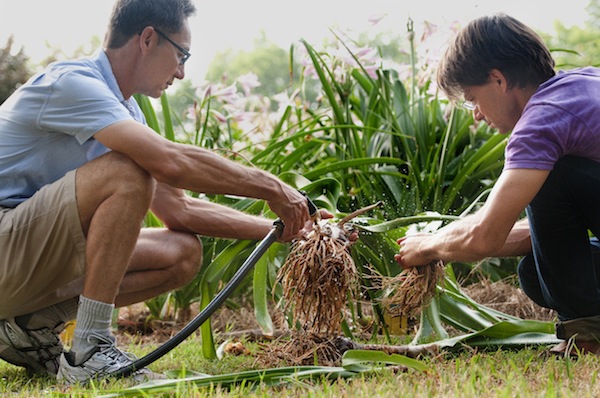
It was in the summer of 1994, when I was visiting south Georgia and Florida nurseries, that I was wandering the extensive grounds of The Tree Farm, at that time a large nursery in downtown Gainesville, Florida. I discovered they had several varieties of crinum available, and they actually knew the varieties’ names and breeders. As I made my choices, the plantsman who was attending my visit said with some emphasis, “You know, if you’re in South Carolina and you’re into crinums, you should have run into Jenks Farmer.”
I had not run into Jenks Farmer. I did learn that he was a young plantsman also searching for crinum bulbs, buying up numbers of varieties; and that he was using some of them in his project building a new botanical garden in Columbia, the state capital.
After that encounter it seemed that every crinum connection I discovered had already been well-plucked by Jenks Farmer. Nonetheless, I began to acquire a number of species and varieties of crinum for my garden and my edification, eventually having several dozen different types to learn from and admire. Having gotten a good start on my original goal, I forgot about that other crinum enthusiast.
A year later, the Riverbanks Botanic Garden in Columbia opened to much fanfare and critical praise. Its founding director, I read, was a young horticulturist named Jenks Farmer. It appeared the rumors among the nurserymen had been true.
Recently, I drove down another red clay road, past the entrance to old Governor Hammond’s plantation, straight through the ancient magnolia allée (planted when its sister magnolia allée was established where the Augusta National Golf Club is now). Turning a corner, I came to a lovely two-story country house built in the 18th century surrounded by ancient trees and gardens. Behind the fine house, the old outbuildings protected chickens, donkeys, dogs, cats, and the paraphernalia associated with working an old farm. There were pecan trees, flower gardens laid out in loose, joyful style, and well-worn paths to clothes lines and outbuildings and pens. And there were rows upon rows of exuberant colorful crinums growing in their own field.
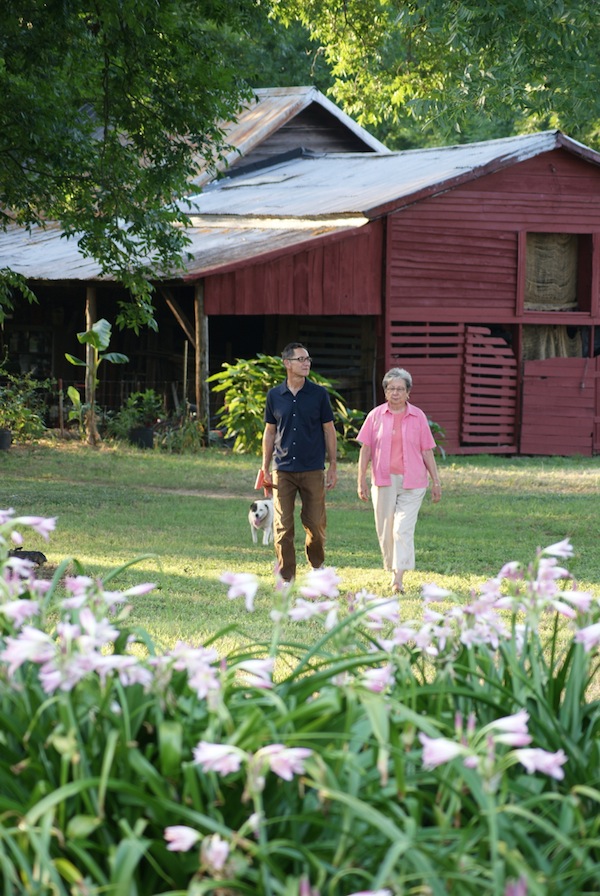
This was the home of Gloria Farmer, the home where Jenks Farmer grew up, and the site of his now internationally-known nursery. I was there at the invitation of Miss Gloria, Jenks, and his partner Tom Hall, to meet other crinum enthusiasts and to enjoy a “crinum cocktail party.” That genial and convivial group of children and elders, plant people and good-old-boys, ladies whose hands shovel dung and ladies whose hands rarely touch dirt—that group, I came to learn, was typical of the coterie always around Jenks.
Since his days scrounging crinum bulbs around the southeast, Jenks has done more than help lead the creation of the Riverbanks Botanic Garden. He has been central in the creation of another great botanic garden in the Pee Dee area of South Carolina; his lectures and presentations around the country are crowded at every stop; his articles and essays in numerous publications spread delight and excellent information about gardening conscientiously, the joy of plants, and the unmatched pleasure of turning depleted sites into healthy productive gardens.
The root of Jenks’s horticultural success is a unique blending of scientific knowledge with tried-and-true understanding of successful old-fashioned gardening and farming methods, two philosophies which often have been in bitter conflict in modern times. Jenks has earned his mastery of the science portion with university degrees, study and experimentation. His grasp of the traditional approaches comes from decades of tutelage and work alongside gifted gardeners, farmers, and teachers—mentors who have molded the earth and the lives of learners willing to listen attentively.
Now Jenks has taken a leap. Long a teacher himself and a compassionate advocate for working sustainably and with conscious regard for the health of the environment, he has written a book.
Most gardening books seem to fall into one of two categories: pretty books filled with photographs of unattainable gardens, or how-to tutorials on a particular technique or style. Jenks has done something rather different here. Deep-Rooted Wisdom urges a different way of thinking about gardening, of learning from one’s forebears, of identifying valuable traditions which may work better in our technological world than modern approaches. He does it with sumptuously beautiful photographs, with careful descriptions of how he came to learn a particular approach or technique, and with loving encounters with the old-timers and mentors who molded his perceptions and knowledge and skills. And with more than a touch of humor.
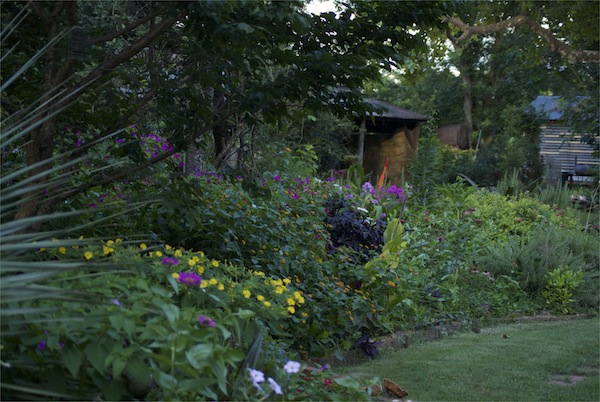
To be sure, there are a number of books that attempt to preach sustainability, or organic gardening, or healthy eating. This is not one of those. First of all, Jenks isn’t a preacher. He’d rather show you how his fields, using his soil-building methods, have gotten deeper and richer with the passing years; while the farmer next door, using standard practices, has lost countless tons of topsoil in the same years. It is dramatically visible, as there is now an eight-inch drop off at the fence line between the two fields.
Jenks employs extensive scientific knowledge and methods in developing his approach to successful gardening. The subtitle is “Skills and Stories from Generations of Gardeners,” and he brings the hard-won knowledge of dirty-hands gardeners you may never have heard of, and some other gardeners—similarly generous with their own earned wisdom—with world-wide reputations. All have played significant and deeply personal roles in Jenks’s education.
The book is very carefully structured to present one of a number of gardening challenges, each section introducing the reader to two gardeners, their gardens, and a particular gardening insight to be learned from them. This provides a basis for Jenks to examine how these techniques fit in the real world we garden in, and then he illustrates further with how these particular problems and solutions have been adapted and employed in his gardening on the farm and in his clients’ gardens around the world. Finally, he gleans from nationally known gardeners their own perceptions of the issues at hand. Such renowned gardeners as Felder Rushing, Ruth Knopf, Ryan Gainey—Frances Parker from my home town of Beaufort, South Carolina—and others contribute significantly to the book.
All this is complemented with magnificent photographs of plants and gardens, projects and pathways, flowers and creatures. A large format book, in paperback, it is the kind of book which leaves me not wanting to quote from it or describe it; the writing is beautiful, the ideas are substantial and feel right, the essential humane compassion and generosity of the man are evident in every paragraph.
Deep-Rooted Wisdom is available from the usual sources online; from Timber Press; directly from Jenks Farmer; or from your local independent bookstore. Readers in Great Britain, New Zealand, and Australia should have copies available in local bookstores soon.
Note: The photograph of Buck, Jenks, and his niece was taken by Tom Hall; the photographs of the outhouse and of Tom and Jenks washing bulbs were taken by Melsharo, with copyright for the latter belonging to Timber Press; the photographs of Tom walking with Gloria and of Gloria’s evening border were taken by Jenks Farmer. Used with permission.
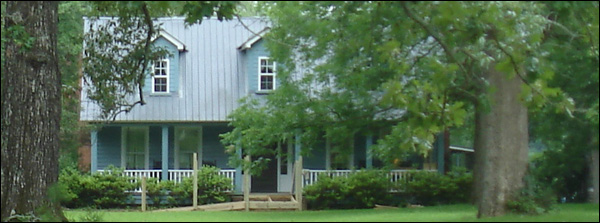
7 Comments
Elizabeth Boleman-Herring
Will, the book is glorious–a truly moveable feast. My copy arrived today, along with this review’s posting. It’s something of a miracle when a “book review” actually captures the spirit of its subject(s), but this one does. Jenks’s life’s work–AND his book–comprise a mikrokosmos in which we all would love, and should aspire to live. I’ve been writing and reading and editing all my life, and I’ve never seen a book such as this: a reader, an artist, a gardener, a preservationist, a Humanist—all will simply swoon into it. Thank you for writing this piece, and for introducing us all–far-flung out here–to Augustus Jenks Farmer.
Will Balk, Jr.
Thank you, lovely editor; and thanks to Jenks Farmer as well, for making such a wonderful book to inspire us all. And gratitude is due, too, to the mainstream publisher (Timber Press), who took a chance on this author and this book. They had to have shared at least a bit in the joyful and comprehensive vision Jenks puts forth with his work and his life.
Jenks
Well Elizabeth, I’m blushing.
Linda Christine
I always enjoy reading your columns and always read things my friend Jenks either writes for different magazines and am enjoying his book…it is always such a wonderful visit with my dear friend Gloria and at times see Jenks and Tom there also..For Mother’s Day my daughter Donna and Granddaughter Rebecca spent part of Mother’s Day with me and the Farmers…wonderful pictures taken. Also, so special that my 19 yr. old granddaughter loves to go there also..
Will
Linda, the Farmers are indeed special people; it’s wonderful to have such friends, and wonderful to have such a gifted gardener and writer as Jenks is among them. Thanks for reading, Linda.
diana
Sounds like a ‘must’ for all serious gardeners to possess and pore over. Wish you could have been with us on our recent trip to Pelion for 5 days of garden visits, most of them on very steep slopes overlooking peacock blue seas and arranged around ancient olive trees but also coursing with streams. No water shortage in that part of the Med. And everyone — visitors and locals — eagerly sharing lore, cuttings and iris tubers.
Will
Diana, your description of visiting Pelion makes me jealous; what a wonderful 5 days! (I’m driving through Pelion today, on my way to the South Carolina Book Festival Weekend. This Pelion, however, lacks views of “peacock blue seas”). And streams of water! Perfect!